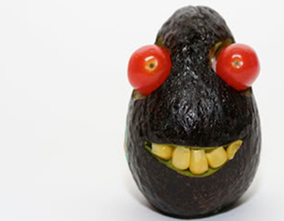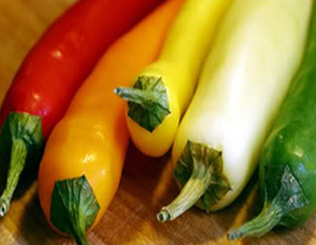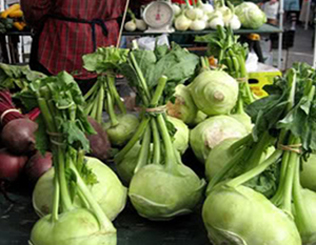Issue :- 5
BEAT THE HEAT THIS SUMMER WITH VEGETABLES

Arugula
A fixture of many-a-bistro salad, arugula is an excellent source of folate and vitamin C as well as a good source of calcium. Although arugula is typically mildly flavored, larger leaf varieties can have a more peppery, almost hot taste than the smaller, softer leaf variety, so choose your arugula accordingly! Arugula is typically best served in a salad with olives, hard-boiled eggs, onions and salty cheeses and is most flavorful when paired with lemon juice or vinaigrettes with a strong acid content, such as aged red wine.

Avocados
Although available year round, California’s Hass avocados are at their peak in the summer months! Touted most frequently for their high quantity of good fat (or oleic, monounsaturated and therefore heart-healthy fat), avocados are also an excellent source of potassium, folate and vitamins C and B6, and are considered a good source of thiamin, riboflavin, niacin and magnesium. In addition, avocados also contain a compound that helps with the absorption of healthy carotenoids from vegetables, making them a welcome addition to a seasonal chopped salad (or when combined with store-bought salsa for a quickie guacamole) To pick the perfect avocado, look for those that have a uniform and unblemished skin that gives gently when pressed.

Blueberries
Although technically a fruit, blueberries are just too darn delicious to pass up for the summer season. Relatively low in calories and carbohydrates, blueberries boast a ridiculously high level of antioxidants that protect against free-radical activity that can cause cataracts, glaucoma, varicose veins, hemorrhoids, peptic ulcers, heart disease and cancer. In addition, blueberries also boast a high level of vitamin C, manganese and dietary fiber. When selecting blueberries, look for those that are firm, deeply hued and are stored in containers that allow them to move freely and do not appear moist (both of which can lead to premature molding). Store in a cold, dry place and wash only when ready to serve as moisture can damage the berries or spur the degeneration process. Blueberries can be eaten alone, added to breakfast smoothies or protein shakes, sprinkled on top of a salad or served as a desert with fresh cream.

Cucumbers
A member of the squash family, cucumber’s high water content makes it a refreshing (and hydrating) addition to summer menus. Although comprised primarily of water, cucumber is also a good source of vitamin C and silica, which is important for connective tissue health and also does wonders for the skin (both when ingested or applied topically to reduce swelling or redness). In addition, the skin of the cucumber is a great source of fiber, potassium and magnesium. When selecting a cucumber, look for slender cucumbers (which are a sign of their tender age) and those with dark green, firm skins. Cucumbers can be added raw to salads, sandwiches, soups or dips and are most flavorful when paired with chives, dill, mint and salt and vinegar.

Eggplant
Clove oil uses seem almost endless. Touted as a potential cure for everything from headaches to digestive troubles thanks to its mighty antioxidant properties, clove essential oil also has many practical applications in the beauty department, although it's underlying benefits to both skin and nails are still medicinal in nature.

Hot Peppers
Hot peppers may have made Oprah’s list of top super foods (you know how we feel about the term super foods!) but there is a lot to be said for good ol’ hot peppers. Chief among its benefits, hot peppers boast a hefty dose of capsaicin, a compound that can alleviate the symptoms of migraine headaches, arthritis, inflammation, gastric ailments (really!), reduce the risk of cancer AND serve as a thermogenic agent to speed metabolic activity. In addition, hot peppers are high in antioxidant carotenes and flavonoids, and contain about twice the amount of vitamin C as oranges. Due to the intense flavor of the peppers, they are best used to spice up everyday soups, stews, chili dishes, stir fries, salads and salsas.

Kohlrabi
Often referred to as cabbage turnip, this green vegetable looks almost like an oversized radish, complete with a ball-like bulb and bushy sprouting leaves. When selecting a kohlrabi, look for smallish, firm bulbs less than 3 inches in diameter (the larger ones tend to be woody and have a more earthy taste). So why stock up? First, kohlrabi is an excellent source of vitamin C as well as potassium. When raw, it can be added to salads and vegetable platters or served as relish. When cooked, it can be steamed for inclusion in casseroles or hollowed out, stuffed with a meat or vegetable filling and oven baked much like a stuffed pepper.

Mushrooms
Although there are different types of mushrooms available year round, summer is the season for chanterelles and porcinis varieties. With a low sodium and fat content and high levels of fiber and riboflavin, niacin, potassium and riboflavin, mushrooms are an excellent way to add bulk to a meal without dramatically changing the nutrition content of foods. When shopping for mushrooms, they should be dry and firm and, if open, should have gills that are intact and appear fresh. Mushrooms will generally keep for several days if stored in a paper bag in a refrigerator and should be cleaned – preferably with a damp cloth – before cooking. Mushrooms can be served raw, added to salads or sautéed, grilled or broiled for inclusion in any number of dishes.
Nomination form for 2020 Global Awards
https://www.unaniherbal.org/nomination-form.html
For Consultation click here
Copyright 2014 Unani Herbal
If you wish to cancel your subscription to this newsletter click here






